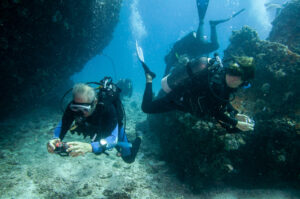What is Compressed Air?
Compressed air, essential in scuba diving, refers to air that has been pressurized to fit into a smaller volume, typically within a scuba tank. This enables divers to breathe underwater for extended periods. Understanding compressed air is vital for divers, as it directly impacts safety, dive planning, and equipment use. Historically and technologically significant, compressed air has evolved through innovations, becoming a cornerstone of modern diving.
History and Development
The concept of compressed air dates back to the early 19th century when inventors began experimenting with ways to extend human breath underwater. One of the earliest pioneers was Augustus Siebe, who developed the closed diving helmet in the 1830s. This innovation allowed divers to stay submerged for longer periods by supplying air from the surface through hoses. However, it wasn’t until the mid-20th century that significant advancements in compressed air technology revolutionized scuba diving.
In the 1940s, Jacques-Yves Cousteau and Émile Gagnan invented the Aqua-Lung, the first open-circuit scuba system. This apparatus used compressed air stored in tanks, enabling divers to explore underwater without being tethered to the surface. This breakthrough not only increased the range and freedom of divers but also laid the groundwork for recreational diving. Over the decades, continued improvements in compressor technology, materials, and safety standards have made compressed air more accessible and reliable for divers worldwide.
Modern developments in the field have focused on enhancing the safety, efficiency, and portability of compressed air systems. Innovations such as high-pressure compressors, advanced filtration systems, and lightweight, durable tanks have furthered the capabilities and appeal of scuba diving. These advancements have also extended the use of compressed air beyond recreational diving into commercial, scientific, and military applications.
Physical and Chemical Properties
Compressed air is regular atmospheric air that has been pressurized to fit into a smaller volume, typically within a scuba tank. Standard atmospheric air consists of approximately 78% nitrogen, 21% oxygen, and trace amounts of other gases such as argon and carbon dioxide. When compressed, the volume of air is reduced, but its composition remains the same.
The process of compressing air involves mechanical devices known as compressors, which reduce the air volume by increasing its pressure. This increase in pressure causes the air to become denser, allowing a larger quantity of air to be stored in a tank. For example, a typical scuba tank might hold air compressed to a pressure of 200 bar (2900 psi), which significantly reduces the air’s volume compared to its volume at standard atmospheric pressure.
Chemically, compressed air behaves similarly to uncompressed air, but the high pressures involved in scuba diving can affect the gases’ physical properties. Underwater, the increased pressure affects how gases dissolve in the body. For instance, nitrogen, which is inert at surface pressure, can become problematic at higher pressures, leading to conditions like nitrogen narcosis or decompression sickness. Understanding these properties is crucial for divers to plan their dives safely and avoid potential hazards.
Compressed Air vs. Other Breathing Gases
While compressed air is the most commonly used breathing gas in scuba diving, other gases such as nitrox, trimix, and heliox are also utilized for specific purposes. Nitrox, a mixture of nitrogen and oxygen with a higher oxygen content than regular air, is often used to reduce nitrogen absorption and extend bottom times. Trimix, a blend of oxygen, nitrogen, and helium, is employed for deep diving to mitigate nitrogen narcosis and oxygen toxicity.
The primary advantage of compressed air is its simplicity and availability. It is suitable for recreational diving within no-decompression limits and at moderate depths, typically up to 40 meters (131 feet). However, for dives requiring longer durations, deeper depths, or specific physiological needs, alternative gas mixtures offer significant benefits.
For example, nitrox reduces the risk of decompression sickness by lowering the proportion of nitrogen in the breathing mix. This makes it ideal for extended bottom times and repetitive dives. Trimix, on the other hand, is essential for deep technical dives as it minimizes the narcotic effects of nitrogen and the risk of oxygen toxicity, allowing divers to reach greater depths safely. Each gas mixture has its own set of advantages and limitations, making it essential for divers to choose the appropriate breathing gas for their specific dive plan.
Equipment Used for Compressing Air
Compressing air for scuba tanks requires specialized equipment known as compressors. These machines come in various types, including high-pressure compressors designed specifically for filling scuba tanks. The primary function of these compressors is to take ambient air and compress it to the high pressures required for scuba diving, typically between 200 and 300 bar (2900 to 4350 psi).
High-pressure compressors operate in stages, gradually increasing the air pressure through a series of compression chambers. Each stage compresses the air to a higher pressure, with cooling mechanisms to dissipate the heat generated during compression. This multi-stage process ensures that the air is compressed efficiently and safely to the desired pressure.
Maintenance and safety procedures are crucial when handling compressed air equipment. Regular maintenance includes checking and replacing filters, monitoring compressor oil levels, and inspecting hoses and connections for wear and damage. Ensuring the air quality is also essential, as contaminants such as oil, water, and carbon monoxide can pose serious health risks to divers. Filtration systems are used to remove these impurities, providing clean, breathable air for diving.
Recent advancements in compressor technology have focused on improving efficiency, portability, and air quality. Modern compressors are often equipped with advanced filtration systems, digital controls, and automated monitoring features, making them more reliable and user-friendly. These innovations have made it easier for dive operators and enthusiasts to safely fill scuba tanks with high-quality compressed air.
Risks and Safety Measures
Using compressed air in scuba diving presents several risks, primarily related to the physiological effects of breathing compressed gases at high pressures. One of the most significant risks is decompression sickness, also known as “the bends.” This condition occurs when nitrogen absorbed by the body under pressure forms bubbles in the bloodstream and tissues as the diver ascends and pressure decreases. To mitigate this risk, divers must follow controlled ascent rates and decompression schedules.
Another potential hazard is oxygen toxicity, which can occur when breathing high concentrations of oxygen at increased pressures. This condition can cause symptoms ranging from visual disturbances and nausea to convulsions and loss of consciousness. Divers must adhere to depth limits and oxygen exposure guidelines to avoid oxygen toxicity.
Nitrogen narcosis, often referred to as “rapture of the deep,” is another risk associated with breathing compressed air at depth. It is a reversible condition that impairs cognitive function and motor skills, similar to the effects of alcohol intoxication. The severity of nitrogen narcosis increases with depth, making it important for divers to recognize its symptoms and manage their depth and time underwater accordingly.
To ensure safety, divers must follow established protocols and undergo proper training. This includes understanding dive tables and algorithms, using dive computers to monitor depth and time, and performing pre-dive equipment checks. Emergency procedures, such as buddy breathing and controlled emergency ascents, are also critical components of dive training.
Air quality is another important safety consideration. Compressors must be maintained to prevent contamination of the air supply, and regular air tests should be conducted to ensure it meets safety standards. Using clean, dry air reduces the risk of respiratory issues and other health problems related to contaminated air.
Applications of Compressed Air in Scuba Diving
Compressed air is the primary breathing gas for recreational, commercial, and scientific diving. In recreational diving, it allows enthusiasts to explore underwater environments, from coral reefs to shipwrecks. Compressed air is easily accessible, making it the standard choice for most recreational divers.
In commercial diving, compressed air is used for various underwater tasks such as construction, inspection, and maintenance of underwater structures. Commercial divers often work at shallower depths where compressed air is suitable, but they may switch to other gas mixtures for deeper or more extended operations.
Scientific diving relies on compressed air for underwater research and data collection. Marine biologists, archaeologists, and environmental scientists use scuba equipment to conduct surveys, collect samples, and document underwater habitats. The simplicity and availability of compressed air make it a practical choice for many scientific diving operations.
Technical diving, which involves exploring depths beyond the limits of recreational diving, often starts with compressed air but may incorporate other gas mixtures as needed. Technical divers use advanced techniques and equipment to reach depths where standard compressed air would be unsafe due to nitrogen narcosis and oxygen toxicity.
Rescue and public safety diving also utilize compressed air. Divers in these fields perform search and recovery operations, underwater investigations, and emergency response tasks. The reliability and effectiveness of compressed air systems are crucial for these high-stakes activities.
Future Trends and Innovations
The future of compressed air in scuba diving is marked by ongoing technological advancements and innovations. One significant trend is the development of more efficient and portable compressor systems. Innovations in materials and design are making compressors lighter, more durable, and easier to transport, which is particularly beneficial for remote diving locations.
Another area of advancement is in air purification and filtration technology. Enhanced filtration systems are being developed to ensure the highest quality of compressed air, reducing the risk of contaminants and improving diver safety. These systems are becoming more sophisticated, with automated monitoring and maintenance features to ensure consistent air quality.
Digital technology is also playing a role in the evolution of compressed air systems. Modern compressors are equipped with digital controls and diagnostic tools that provide real-time data on air quality, pressure, and system performance. This integration of digital technology enhances the reliability and ease of use of compressed air equipment.
Emerging research in gas blending technology may lead to new gas mixtures that optimize safety and performance for divers. While compressed air remains the standard, advancements in understanding gas physiology and decompression theory could result in the development of customized gas blends tailored to specific diving profiles and conditions.
Key Takeaways
Compressed air is an indispensable component of scuba diving, enabling divers to explore underwater realms safely and effectively. Its proper use and understanding are crucial for managing the inherent risks of diving, such as decompression sickness and nitrogen narcosis. By adhering to safety standards, maintaining equipment rigorously, and choosing the right air mix for specific dive conditions, divers can optimize their underwater experiences. As technology advances, the continued innovation in compressor efficiency, air purification, and digital monitoring will enhance the safety, accessibility, and environmental sustainability of diving with compressed air.

















